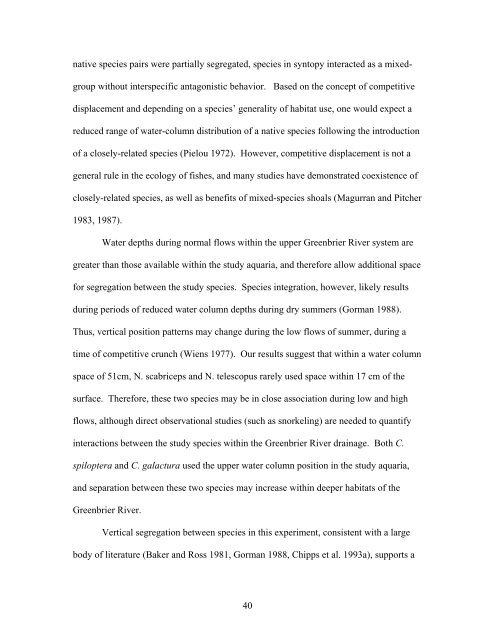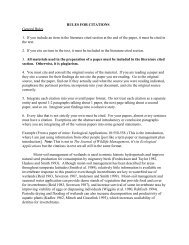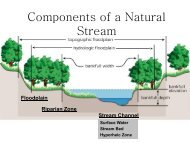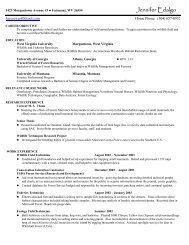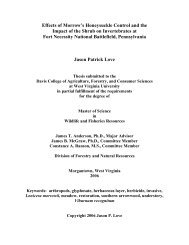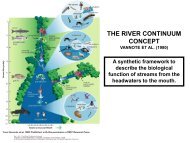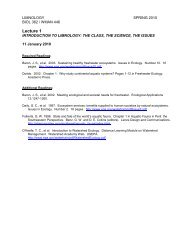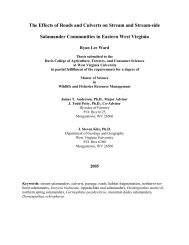An Experimental Study of Vertical Habitat Use and Habitat Shifts in ...
An Experimental Study of Vertical Habitat Use and Habitat Shifts in ...
An Experimental Study of Vertical Habitat Use and Habitat Shifts in ...
You also want an ePaper? Increase the reach of your titles
YUMPU automatically turns print PDFs into web optimized ePapers that Google loves.
native species pairs were partially segregated, species <strong>in</strong> syntopy <strong>in</strong>teracted as a mixedgroup<br />
without <strong>in</strong>terspecific antagonistic behavior. Based on the concept <strong>of</strong> competitive<br />
displacement <strong>and</strong> depend<strong>in</strong>g on a species’ generality <strong>of</strong> habitat use, one would expect a<br />
reduced range <strong>of</strong> water-column distribution <strong>of</strong> a native species follow<strong>in</strong>g the <strong>in</strong>troduction<br />
<strong>of</strong> a closely-related species (Pielou 1972). However, competitive displacement is not a<br />
general rule <strong>in</strong> the ecology <strong>of</strong> fishes, <strong>and</strong> many studies have demonstrated coexistence <strong>of</strong><br />
closely-related species, as well as benefits <strong>of</strong> mixed-species shoals (Magurran <strong>and</strong> Pitcher<br />
1983, 1987).<br />
Water depths dur<strong>in</strong>g normal flows with<strong>in</strong> the upper Greenbrier River system are<br />
greater than those available with<strong>in</strong> the study aquaria, <strong>and</strong> therefore allow additional space<br />
for segregation between the study species. Species <strong>in</strong>tegration, however, likely results<br />
dur<strong>in</strong>g periods <strong>of</strong> reduced water column depths dur<strong>in</strong>g dry summers (Gorman 1988).<br />
Thus, vertical position patterns may change dur<strong>in</strong>g the low flows <strong>of</strong> summer, dur<strong>in</strong>g a<br />
time <strong>of</strong> competitive crunch (Wiens 1977). Our results suggest that with<strong>in</strong> a water column<br />
space <strong>of</strong> 51cm, N. scabriceps <strong>and</strong> N. telescopus rarely used space with<strong>in</strong> 17 cm <strong>of</strong> the<br />
surface. Therefore, these two species may be <strong>in</strong> close association dur<strong>in</strong>g low <strong>and</strong> high<br />
flows, although direct observational studies (such as snorkel<strong>in</strong>g) are needed to quantify<br />
<strong>in</strong>teractions between the study species with<strong>in</strong> the Greenbrier River dra<strong>in</strong>age. Both C.<br />
spiloptera <strong>and</strong> C. galactura used the upper water column position <strong>in</strong> the study aquaria,<br />
<strong>and</strong> separation between these two species may <strong>in</strong>crease with<strong>in</strong> deeper habitats <strong>of</strong> the<br />
Greenbrier River.<br />
<strong>Vertical</strong> segregation between species <strong>in</strong> this experiment, consistent with a large<br />
body <strong>of</strong> literature (Baker <strong>and</strong> Ross 1981, Gorman 1988, Chipps et al. 1993a), supports a<br />
40


